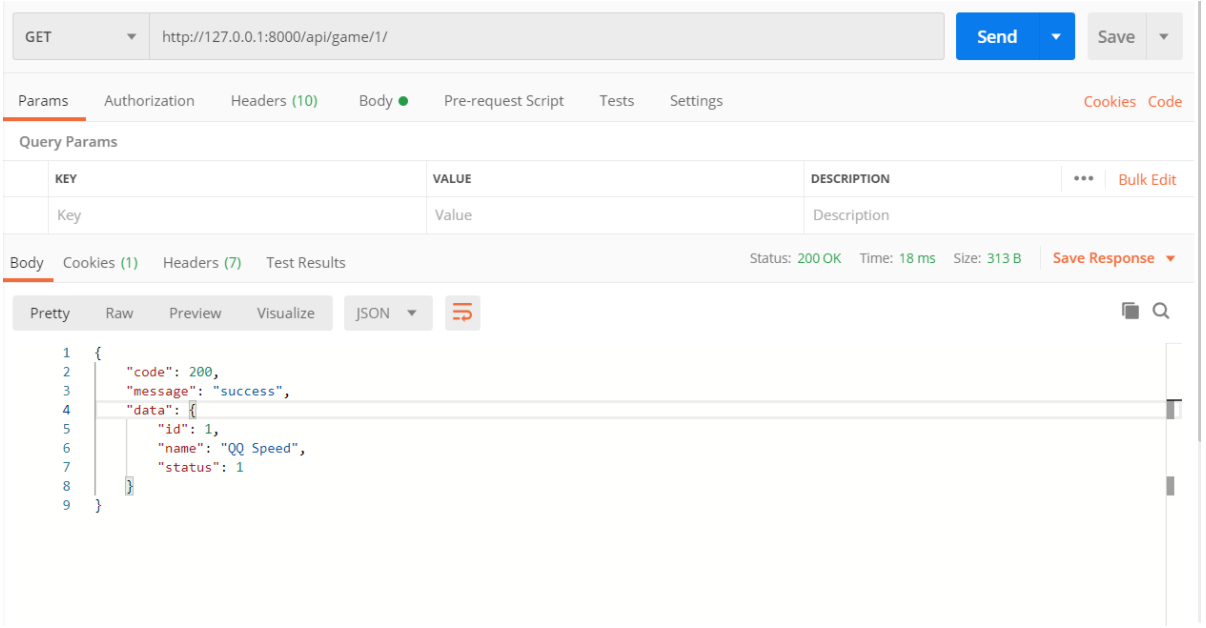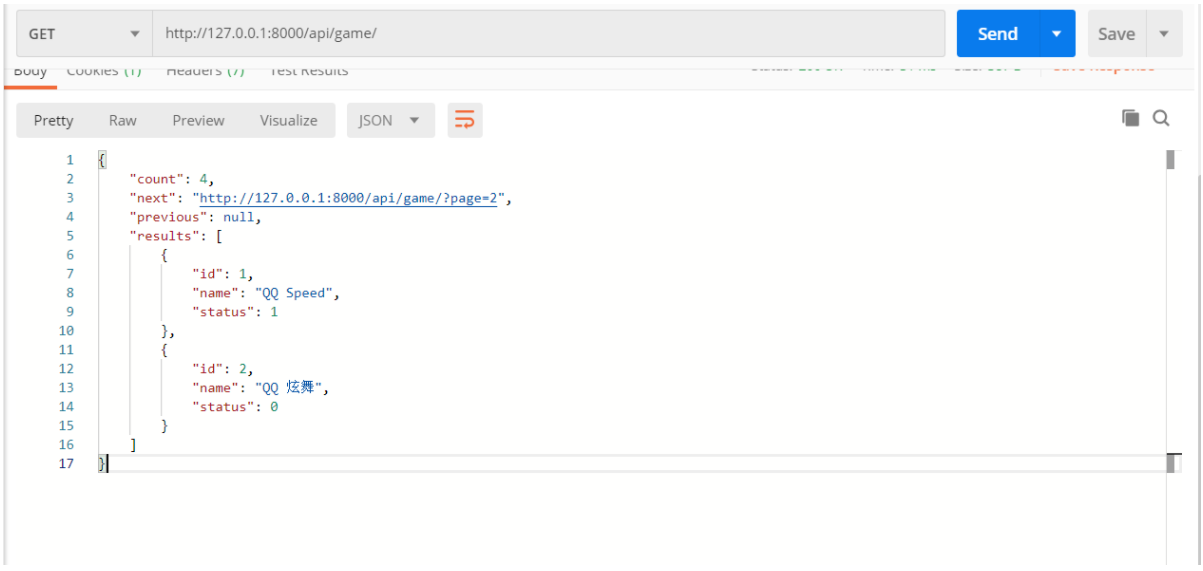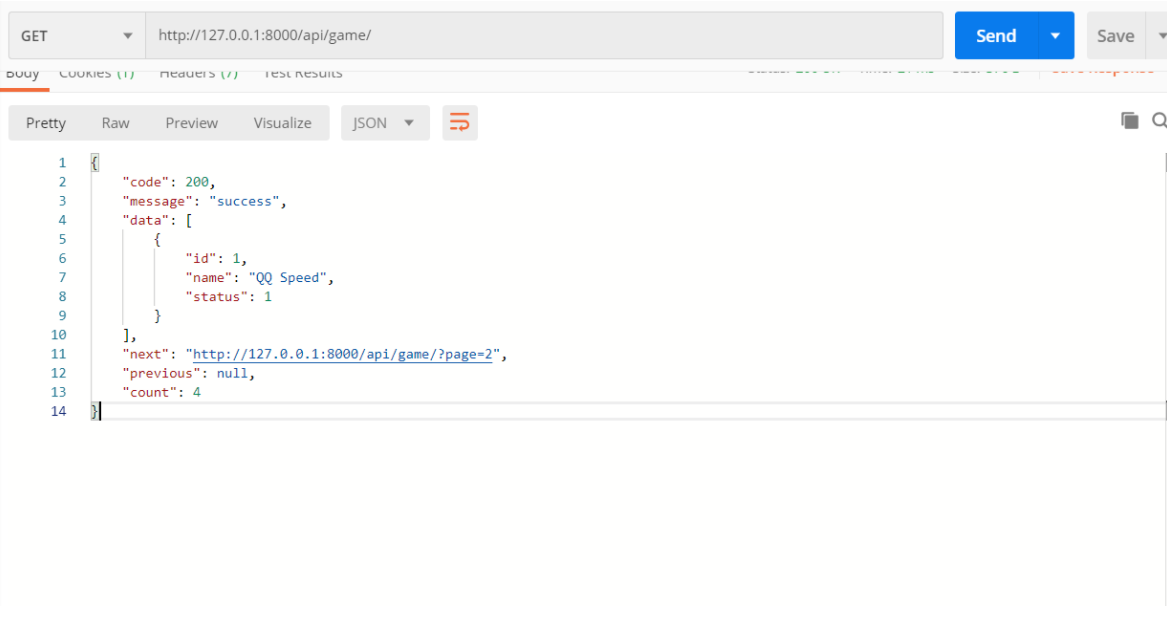 自定义响应格式
自定义响应格式
# 1. 自定义响应格式介绍
之前我们讲了自定义异常,主要目的是为了方便移动端开发使用的,但是我们在给移动端提供正常的响应格式的时候,也要像自定义异常一样,具有一定的格式。目前我们返回的数据格式是这样的:
{
"next": "http://127.0.0.1:8000/api/v1/games/?cursor=cD0x",
"previous": null,
"results": [
{
"id": 1,
"name": "帅高高",
"status": 0
}
]
}
2
3
4
5
6
7
8
9
10
11
或者:
{
"id": 1,
"name": "帅高高",
"status": 0
}
2
3
4
5
还是那句话,返回这样格式的数据,对于移动端是不友好的,所以我们需要自定义返回消息,返回的结构如下 :
{
"code": 200,
"message": "success",
"data": [
{
"id": 1,
"name": "帅高高",
"status": 0
}
],
"next": "http://127.0.0.1:8000/api/v1/games/?cursor=cD0x",
"previous": null
}
2
3
4
5
6
7
8
9
10
11
12
13
或者:
{
"code": 200,
"message": "success",
"data": {
"id": 1,
"name": "帅高高",
"status": 0
}
}
2
3
4
5
6
7
8
9
# 2. 自定义JSONResponse
# 2.1 目录结构
说明:其实是一样的,我们需要新建一个 custom_json_response.py 文件,来自定义我们的 JSONResponse
...
-app06
-migrations
...
-apps.py
-admins.py
-models.py
-custom_json_response.py #新建来自定义我们的 JSONResponse
-custom_model_view_set.py #新建,自定义ModelViewSet
-mypagenumberpaginations.py #编辑,分页功能的修改
....
...
2
3
4
5
6
7
8
9
10
11
12
# 2.2 自定义 JSONResponse
说明:在我们新建的custom_json_response.py中 自定义我们的 JSONResponse。
from django.utils import six
from rest_framework.response import Response
from rest_framework.serializers import Serializer
class JsonResponse(Response):
"""
An HttpResponse that allows its data to be rendered into
arbitrary media types.
"""
def __init__(self, data=None, code=None, msg=None,
status=None,
template_name=None, headers=None,
exception=False, content_type=None, **kwargs):
"""
Alters the init arguments slightly.
For example, drop 'template_name', and instead use 'data'.
Setting 'renderer' and 'media_type' will typically be deferred,
For example being set automatically by the `APIView`.
"""
super(Response, self).__init__(None, status=status)
if isinstance(data, Serializer):
msg = (
'You passed a Serializer instance as data, but '
'probably meant to pass serialized `.data` or '
'`.error`. representation.'
)
raise AssertionError(msg)
self.data = {"code": code, "message": msg, "data": data}
self.data.update(kwargs)
self.template_name = template_name
self.exception = exception
self.content_type = content_type
if headers:
for name, value in six.iteritems(headers):
self[name] = value
2
3
4
5
6
7
8
9
10
11
12
13
14
15
16
17
18
19
20
21
22
23
24
25
26
27
28
29
30
31
32
33
34
35
36
37
38
39
# 2.3 APIView使用自定义响应
说明:其实很简单,APIView中很简单的,只需要把 Response 使用为JsonResponse:
from app06.custom_json_response import JsonResponse #导入自定义响应格式
class UserDetail(APIView):
.....
def get(self,request, *args, **kwargs):
user = self.get_object(kwargs.get('id'))
ser = UserSerializer(instance=user,context={"request": request})
return JsonResponse(ser.data, code=200, msg='ok') #使用自定义JsonResponse格式
....
2
3
4
5
6
7
8
9
10
11
12
# 3. 自定义ModelViewSet
为啥我们需要自定义ModelViewSet呐。因为我们ModelViewSet 默认不是用我们的 自定义的 JsonResponse,而是采用默认的。响应格式已经高度封装了,所以这边自己写一个就是了。首先我们来看看源码带,是不是已经封装好了:
Ctrl + ModelViewSet => CreateModelMixin
来看下:
class CreateModelMixin(object):
"""
Create a model instance.
"""
def create(self, request, *args, **kwargs):
....
return Response(serializer.data, status=status.HTTP_201_CREATED, headers=headers) #用默认的
2
3
4
5
6
7
好咧,那我们自己封装一个,首先创建 custom_model_view_set.py 文件:
from rest_framework import status
from rest_framework import viewsets
from .custom_json_response import JsonResponse
class CustomModelViewSet(viewsets.ModelViewSet):
def create(self, request, *args, **kwargs):
serializer = self.get_serializer(data=request.data)
serializer.is_valid(raise_exception=True)
self.perform_create(serializer)
headers = self.get_success_headers(serializer.data)
return JsonResponse(data=serializer.data, msg="success", code=201, status=status.HTTP_201_CREATED,
headers=headers)
def list(self, request, *args, **kwargs):
queryset = self.filter_queryset(self.get_queryset())
page = self.paginate_queryset(queryset)
if page is not None:
serializer = self.get_serializer(page, many=True)
return self.get_paginated_response(serializer.data)
serializer = self.get_serializer(queryset, many=True)
return JsonResponse(data=serializer.data, code=200, msg="success", status=status.HTTP_200_OK)
def retrieve(self, request, *args, **kwargs):
instance = self.get_object()
serializer = self.get_serializer(instance)
return JsonResponse(data=serializer.data, code=200, msg="success", status=status.HTTP_200_OK)
def update(self, request, *args, **kwargs):
partial = kwargs.pop('partial', False)
instance = self.get_object()
serializer = self.get_serializer(instance, data=request.data, partial=partial)
serializer.is_valid(raise_exception=True)
self.perform_update(serializer)
if getattr(instance, '_prefetched_objects_cache', None):
# If 'prefetch_related' has been applied to a queryset, we need to
# forcibly invalidate the prefetch cache on the instance.
instance._prefetched_objects_cache = {}
return JsonResponse(data=serializer.data, msg="success", code=200, status=status.HTTP_200_OK)
def destroy(self, request, *args, **kwargs):
instance = self.get_object()
self.perform_destroy(instance)
return JsonResponse(data=[], code=204, msg="delete resource success", status=status.HTTP_204_NO_CONTENT)
2
3
4
5
6
7
8
9
10
11
12
13
14
15
16
17
18
19
20
21
22
23
24
25
26
27
28
29
30
31
32
33
34
35
36
37
38
39
40
41
42
43
44
45
46
47
48
好啦,那这样,我就使用自己定义的ModelViewSet在视图中继承使用:
from .custom_model_view_set import CustomModelViewSet #导入自定义的
class GameView(CustomModelViewSet): #继承自定义的
queryset = Game.objects.all()
serializer_class = GameSerializer
2
3
4
5
6
效果图如下:

# 4. 自定义分页类需要修改
我们在分页的时候,没有使用自定义的 JsonRespose,导致如下输出:

那这个不是我们想要的,所以我们需要自定义分页类需要修改,编辑 mypagenumberpaginations.py文件:
from rest_framework.pagination import PageNumberPagination, LimitOffsetPagination, CursorPagination
from .custom_json_response import JsonResponse
from rest_framework import status
#普通分页
class MyPageNumberPagination(PageNumberPagination):
page_size = 1
max_page_size = 1
page_size_query_param = 'size'
page_query_param = 'page'
def get_paginated_response(self, data):
return JsonResponse(data=data, code=200, msg="success", status=status.HTTP_200_OK, next=self.get_next_link(),
previous=self.get_previous_link(), count=self.page.paginator.count)
#切割分页
class MyPageNumberPagination(LimitOffsetPagination):
default_limit = 1
limit_query_param = 'limit'
offset_query_param = 'offset'
max_limit = 2
def get_paginated_response(self, data):
return JsonResponse(data=data, code=200, msg="success", status=status.HTTP_200_OK, next=self.get_next_link(),
previous=self.get_previous_link(), count=self.count)
#加密分页
class MyPageNumberPagination(CursorPagination):
cursor_query_param = 'cursor'
page_size = 1
ordering = 'id'
page_size_query_param = 'size'
max_page_size = 1
def get_paginated_response(self, data):
return JsonResponse(data=data, code=200, msg="success", status=status.HTTP_200_OK, next=self.get_next_link(),
previous=self.get_previous_link())
2
3
4
5
6
7
8
9
10
11
12
13
14
15
16
17
18
19
20
21
22
23
24
25
26
27
28
29
30
31
32
33
34
35
36
37
38
注意:根据需求选择一种分页方式。我们这边选择普通分页来测试:

哈哈,是我们想要的啦。
# 5. 自定义Generics
其实自定义Generics跟我们的 ModelViewSet是一样的效果,这边就废话不多说了,直接上代码吧。原理跟ModelViewSet一样。
from rest_framework import status
from rest_framework import viewsets
from .custom_json_response import JsonResponse
from rest_framework import generics
class ListCreateAPIView(generics.ListCreateAPIView):
def create(self, request, *args, **kwargs):
serializer = self.get_serializer(data=request.data)
serializer.is_valid(raise_exception=True)
self.perform_create(serializer)
headers = self.get_success_headers(serializer.data)
return JsonResponse(data=serializer.data, msg="success", code=201, status=status.HTTP_201_CREATED,
headers=headers)
def list(self, request, *args, **kwargs):
queryset = self.filter_queryset(self.get_queryset())
page = self.paginate_queryset(queryset)
if page is not None:
serializer = self.get_serializer(page, many=True)
return self.get_paginated_response(serializer.data)
serializer = self.get_serializer(queryset, many=True)
return JsonResponse(data=serializer.data, code=200, msg="success", status=status.HTTP_200_OK)
class RetrieveUpdateDestroyAPIView(generics.RetrieveUpdateDestroyAPIView):
def retrieve(self, request, *args, **kwargs):
instance = self.get_object()
serializer = self.get_serializer(instance)
return JsonResponse(data=serializer.data, code=200, msg="success", status=status.HTTP_200_OK)
def update(self, request, *args, **kwargs):
partial = kwargs.pop('partial', False)
instance = self.get_object()
serializer = self.get_serializer(instance, data=request.data, partial=partial)
serializer.is_valid(raise_exception=True)
self.perform_update(serializer)
if getattr(instance, '_prefetched_objects_cache', None):
# If 'prefetch_related' has been applied to a queryset, we need to
# forcibly invalidate the prefetch cache on the instance.
instance._prefetched_objects_cache = {}
return JsonResponse(data=serializer.data, msg="success", code=200, status=status.HTTP_200_OK)
def destroy(self, request, *args, **kwargs):
instance = self.get_object()
self.perform_destroy(instance)
return JsonResponse(data=[], code=204, msg="delete resource success", status=status.HTTP_204_NO_CONTENT)
2
3
4
5
6
7
8
9
10
11
12
13
14
15
16
17
18
19
20
21
22
23
24
25
26
27
28
29
30
31
32
33
34
35
36
37
38
39
40
41
42
43
44
45
46
47
48
49
50
51
52
后面就在对应的视图中导入并使用。
